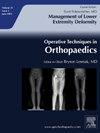臂丛神经及上肢神经损伤的神经转移治疗
IF 0.3
Q4 ORTHOPEDICS
引用次数: 0
摘要
臂丛神经损伤(BPI)和周围神经损伤(PNI)的神经移植已成为手肢和上肢外科医生的重要工具。根据损伤程度的不同,存在大量的供体神经,可用于恢复缺乏的运动功能和/或恢复感觉。通常在BPI术后,患者在肩部外展、外旋和/或肘关节屈伸方面存在缺陷,因此有许多可用的神经转移选择。不幸的是,我们还没有很多成功的技术来恢复完全BPI后的固有手功能,但是有许多技术可以改善PNI设置下的手功能。通常有多个供体可供选择,选择哪个供体是由外科医生决定的,要考虑到是否存在伴随损伤、再生距离和供体切除可能导致的缺陷。为了在神经移植后获得最佳结果的最佳机会,运动和感觉再教育的渐进式康复计划至关重要。下面将介绍BPI和PNI术后运动和感觉功能恢复的多种技术,以及神经移植后典型康复方案的描述。本文章由计算机程序翻译,如有差异,请以英文原文为准。
Nerve Transfers for Brachial Plexus and Upper Extremity Nerve Injuries
Nerve transfer in the setting of both brachial plexus injury (BPI) and peripheral nerve injury (PNI) has become a valuable tool in the armamentarium of the hand and upper extremity surgeon. Depending on the level of injury, numerous donor nerves exist which can be utilized to re-animate deficient motor functions and/or restore sensation. Commonly after BPI, the patient is left with deficiencies in shoulder abduction, external rotation and/or elbow flexion/extension for which there are a host of available nerve transfer options. Unfortunately, we do not yet have many successful techniques to restore intrinsic hand function after complete BPI, however there are numerous techniques to improve hand function in the setting of PNI. Multiple donors are often available, and the decision for which to harvest is at the discretion of the surgeon, taking into consideration the presence of concomitant injury, regenerative distance and deficits which may result from donor harvest. For the best chance at an optimal outcome after nerve transfer, progressive rehabilitation programs for both motor and sensory re-education are critical. Multiple techniques for restoration of motor and sensory function after BPI and PNI are described below, as well as a description of typical rehabilitation protocol after nerve transfer.
求助全文
通过发布文献求助,成功后即可免费获取论文全文。
去求助
来源期刊

Operative Techniques in Orthopaedics
ORTHOPEDICS-
CiteScore
0.40
自引率
0.00%
发文量
40
审稿时长
83 days
期刊介绍:
Operative Techniques in Orthopaedics is an innovative, richly illustrated resource that keeps practitioners informed of significant advances in all areas of surgical management. Each issue of this atlas-style journal explores a single topic, often offering alternate approaches to the same procedure. Its current, definitive information keeps readers in the forefront of their specialty.
 求助内容:
求助内容: 应助结果提醒方式:
应助结果提醒方式:


